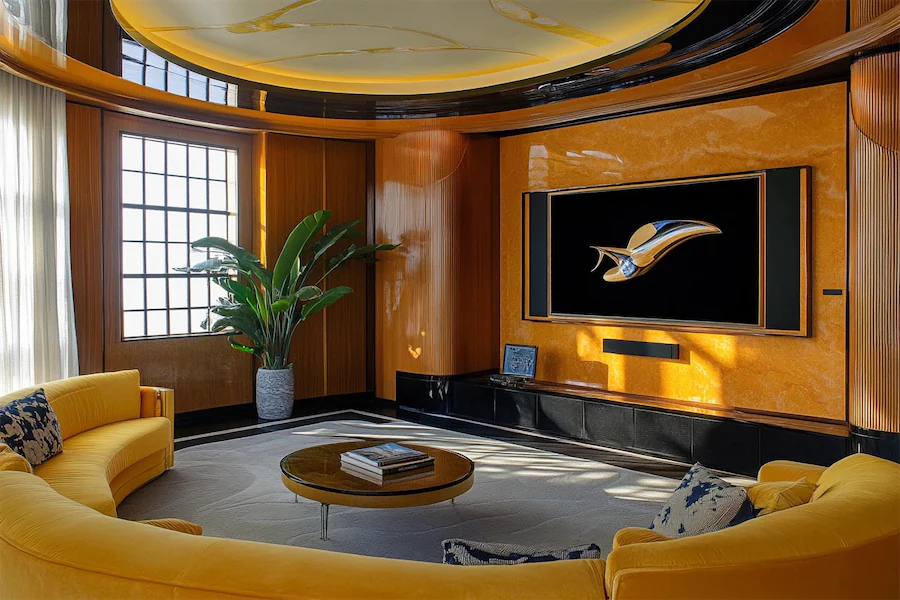Designing an Art Deco Revival entertainment room allows you to infuse your space with the glamour and sophistication of the 1920s and 1930s, updated with modern sensibilities. Here’s a comprehensive guide to achieving this timeless aesthetic:
Introduction to Art Deco Revival Entertainment Rooms
Art Deco Revival, also known as Neo-Deco, reimagines the opulence and geometric elegance of the original Art Deco movement for contemporary interiors. An entertainment room in this style exudes luxury and drama, providing a chic setting for social gatherings and relaxation.
History and Origins of Art Deco Design
Art Deco emerged in the early 20th century, reaching prominence in the 1920s and 1930s. Born in France, the style showcased at the 1925 International Exposition of Modern Industrial and Decorative Arts in Paris, swiftly proliferated across Europe and North America. It encapsulated the era’s spirit of modernity and opulence, standing in contrast to the prevailing styles of the time.
Key Features of Art Deco Revival Entertainment Rooms
- Geometric Patterns: Incorporate bold geometric motifs, such as chevrons, zigzags, and sunbursts, through wallpapers, rugs, and decorative accents to capture the essence of Art Deco design.
- Luxurious Materials: Utilize rich materials like velvet, lacquered wood, marble, and mirrored surfaces to evoke the opulence of the era. High-gloss finishes and mirrored surfaces amplify the sense of luxury, making this style ideal for a glamorous Art Deco living room or entertainment area.
- Bold Color Palettes: Opt for deep jewel tones—emerald green, sapphire blue, ruby red—paired with metallic accents in gold, silver, or chrome to create a dramatic and elegant atmosphere.
- Streamlined Furniture: Select furniture with sleek, curved lines and minimal ornamentation, reflecting the streamlined aesthetics of the Art Deco period. Statement pieces like a bold, geometric-patterned sofa or a mirrored coffee table can anchor the theme in your space.
- Decorative Lighting: Incorporate statement lighting fixtures such as chandeliers, sconces, and table lamps with intricate details and luxurious finishes to enhance the aesthetic.
Applications of Art Deco Revival Style in Entertainment Rooms
- Seating Arrangements: Arrange plush sofas and armchairs upholstered in luxurious fabrics like velvet or satin, complemented by decorative cushions featuring geometric patterns, to create an inviting and stylish seating area.
- Entertainment Center: Choose a sleek, lacquered media console with mirrored or metallic accents to house modern entertainment systems, ensuring it aligns with the Art Deco aesthetic.
- Bar Area: Design a sophisticated bar with a mirrored or marble countertop, complemented by chrome or brass bar stools, to evoke the glamour of the 1920s cocktail lounges.
- Decorative Accents: Adorn the space with period-inspired accessories such as ornate mirrors, sculptures, and artwork featuring geometric designs or motifs inspired by ancient cultures, adding depth and character to the room.
Considerations When Designing an Art Deco Revival Entertainment Room
- Balance: While embracing the opulence of Art Deco, balance bold elements with neutral tones to prevent the space from feeling overwhelming.
- Modern Integration: Ensure that contemporary amenities and technology are seamlessly incorporated, maintaining functionality without compromising the overall aesthetic.
- Personalization: Incorporate personal touches and modern interpretations of Art Deco elements to make the space uniquely yours while staying true to the revival theme.
Conclusion
An Art Deco Revival entertainment room combines historical elegance with modern luxury, creating a glamorous and functional space for entertainment and relaxation. By focusing on geometric patterns, luxurious materials, and thoughtful integration of contemporary amenities, you can craft an environment that pays homage to the opulence of the Art Deco era while catering to today’s lifestyle.
